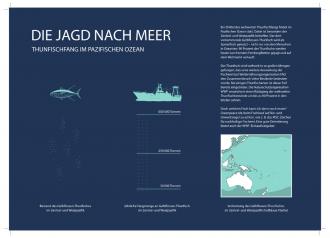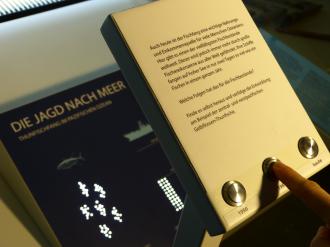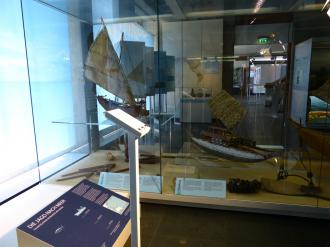How to do it step by step
1st Step:
Choose object and topic
When addressing the topic of overfishing in a museum, certain types of museums and exhibitions are more suitable than others. Types of objects that could be connected to this development topic include boats and ships, fishing nets and other objects used for fishing, and cultural objects related to fishing and oceans. In addition, other hunting tools could also provide a starting point for exploring the topic of fishing.
→ Provide a contrast between the traditional and the modern
It can be interesting for the visitor to compare modern and traditional hunting tools, to show how the increasing efficiency of hunting is contributing towards the endangerment of certain species. In our case, the big industrial fishing trawlers are in stark contrast to the traditional fishing boats used by indigenous populations.
→ Break down cultural diversity into individual lifestyles
Biodiversity in developing countries is a topic that will remain far removed from the museum visitor unless it is not linked to his/her everyday life. Therefore, it is necessary to find connections between the issue and people in Europe. For example, we provided additional information on how much tuna is being exported and sold in industrialized countries like Germany.
→ Less is more
Given the limited attention span of each museum visitor, it is important to present only the most important aspects of the issue, such as the impact on a certain group’s food security, the decrease in a certain fish species, the development of the fishing industry in a specific area, fishing quotas, among other possible aspects.
2nd Step:
Check technical requirements
The use of a light installation involves some restrictions that need to be considered before assigning work to electricians, carpenters and designers. You will need to find a place in the museum without direct sunlight. Otherwise, the installation’s lights will not be seen clearly. You also need to have sockets nearby to supply electricity. In addition, if you plan to place electronic equipment inside glass showcases, you need to find a solution to the issue of cooling in advance. For this reason, we used LEDs to minimize the amount of heat generated within our installation.
The question of how to fix the installation in the museum has an influence on the type of construction used. For example, in our case, we could not fix the installation to the ground, which is why we let the carpenter construct a metal grounding plate to attach the installation to. This provided a stable base for the installation.
3rd Step:
Cost estimates
For the kind of installation that we are describing here, you will need four types of subcontractors: a carpenter to construct a wooden case for the technical equipment, an electrician to install the lights and connect them to the buttons, a designer for the pictures and texts on the wooden case, and a print company to print foils from the designs for attaching to the wooden case.
The cost of a light installation depends very much on what kind of features it has. For example, a greater number of buttons for visitors to press will increase the complexity and thus the price of the light installation. The more lights you want in your installation the more projectors you will need and the higher your costs will be. Lights are illuminated by projectors and these are expensive. Therefore, a clear understanding of what is necessary will make the budget estimates more realistic. In our case, we finally used 5 projectors with 33 lights each adding up to a total of 165 lights. These lights indicate tuna fishes and fishing trawlers. We used only white lights and just three buttons to reduce the price but also because we wanted to keep it simple for visitors to use.
4th Step:
Create content
We incorporated core facts into texts to give an introduction to the topic (see Details section).
5th Step:
Coordinate carpenter, electrician and designers
As there are several subcontractors involved in producing the installation, you should ensure that you carefully coordinate the subcontractors, so that the different parts of the process fit together smoothly. For example, the carpenter needs to deliver a case matching the specifications required by the electrician, while the designers need to know exactly where the lights will be placed and, consequently, how to build a design around the lights, and where exactly the design fits into the overall installation.
6th Step:
Final correction loops
An electrical installation is heavy and bulky, and therefore expensive to transport. It is of paramount importance therefore to check that all elements function before it is transported to the museum.
7th Step:
Installation in the museum
Finalize everything. Once you give the "go-ahead", the final product will be transported to the museum. It will then have to be attached to the museum’s power system and fixed to its location on the ground in a stable manner. Some final work may still be necessary once it is installed in the museum. For example, for our light installation, a final task that was completed in the museum was sealing the blue cover plate with clear varnish to prevent it from becoming stained over time.






















